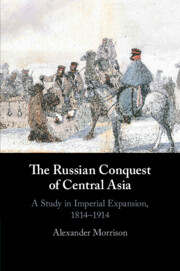Book contents
- The Russian Conquest of Central Asia
- The Russian Conquest of Central Asia
- Copyright page
- Dedication
- Contents
- Illustrations
- Maps
- Tables
- Acknowledgements
- Note on Translation, Transliteration and Dates
- Abbreviations
- Glossary
- Maps
- Introduction
- 1 Russia’s Steppe Frontier and the Napoleonic Generation
- 2 ‘Pray for the Camels’: The Winter Invasion of Khiva, 1839–41
- 3 ‘This Particularly Painful Place’: The Failure of the Syr-Darya Line as a Frontier, 1841–63
- 4 From Ayaguz to Almaty: The Conquest and Settlement of Semirechie, 1843–82
- 5 The Search for a ‘Natural’ Frontier and the Fall of Tashkent, 1863–5
- 6 War with Bukhara, 1866–8
- 7 The Fall of Khiva, 1872–3
- 8 ‘Those Who Should Be Spared’: The Conquest of Ferghana, 1875–6
- 9 ‘The Harder You Hit Them, the Longer They Will Be Quiet Afterwards’: The Conquest of Transcaspia, 1869–85
- 10 Aryanism on the Final Frontier of the Russian Empire: The Exploration and Annexation of the Pamirs, 1881–1905
- Epilogue: After the Conquest
- Sources and Bibliography
- Index
3 - ‘This Particularly Painful Place’: The Failure of the Syr-Darya Line as a Frontier, 1841–63
Published online by Cambridge University Press: 19 November 2020
- The Russian Conquest of Central Asia
- The Russian Conquest of Central Asia
- Copyright page
- Dedication
- Contents
- Illustrations
- Maps
- Tables
- Acknowledgements
- Note on Translation, Transliteration and Dates
- Abbreviations
- Glossary
- Maps
- Introduction
- 1 Russia’s Steppe Frontier and the Napoleonic Generation
- 2 ‘Pray for the Camels’: The Winter Invasion of Khiva, 1839–41
- 3 ‘This Particularly Painful Place’: The Failure of the Syr-Darya Line as a Frontier, 1841–63
- 4 From Ayaguz to Almaty: The Conquest and Settlement of Semirechie, 1843–82
- 5 The Search for a ‘Natural’ Frontier and the Fall of Tashkent, 1863–5
- 6 War with Bukhara, 1866–8
- 7 The Fall of Khiva, 1872–3
- 8 ‘Those Who Should Be Spared’: The Conquest of Ferghana, 1875–6
- 9 ‘The Harder You Hit Them, the Longer They Will Be Quiet Afterwards’: The Conquest of Transcaspia, 1869–85
- 10 Aryanism on the Final Frontier of the Russian Empire: The Exploration and Annexation of the Pamirs, 1881–1905
- Epilogue: After the Conquest
- Sources and Bibliography
- Index
Summary
In the 1840s and 1850s the Russians notionally extended their control much deeper into the steppe, where, after the capture of the Khoqandi fortress of Aq Masjid in 1853, they attempted to consolidate a new frontier along the line of the Syr-Darya, to the east of the Aral Sea. The new fortresses at Raim, Kazalinsk, Karmakchi and Perovsk were islands of Russian sovereignty in an inhospitable landscape of salt-flats, marshland and desert, subject to extremes of cold and heat. Supplying their garrisons was difficult and expensive, and threw the Russians into dependence on Bukharan grain-traders and Qazaq pastoralists. Soldiers were bored out of their minds, and deliberately wounded themselves or deserted to the Khoqandi outposts to the south. While the Syr-Darya frontier was reasonably effective as a listening-post for Russian intelligence and resisted attacks from Khoqand, neither Cossacks nor peasants could be persuaded to settle there, and the costs of occupation far outweighed any revenue. By the late 1850s some voices were calling for a retreat to the Orenburg line, but a familiar argument – that of prestige – won the day, and instead an advance to Tashkent began to seem like the best way of escaping this ‘particularly painful place’.
- Type
- Chapter
- Information
- The Russian Conquest of Central AsiaA Study in Imperial Expansion, 1814–1914, pp. 114 - 167Publisher: Cambridge University PressPrint publication year: 2020



